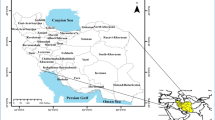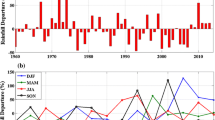Abstract
Drought is one of the major natural disasters causing huge agricultural losses annually. Regional agricultural drought risk assessment has great significance for reducing regional disaster and agricultural drought losses. Based on the fuzzy characteristics of agricultural drought risk, variable fuzzy sets model was used for comprehensively assessing agricultural drought risk of Liaoning Province in China. A multi-layers and multi-indices assessment model was established according to variable fuzzy sets theory, and agricultural drought risk of all 14 prefecture-level cities was respectively estimated in terms of dangerousness, vulnerability, exposure and drought-resistibility. By calculating the combination weights of four drought risk factors, agricultural drought risk grade of each city was obtained. Based on the assessment results, the spatial distribution maps of agricultural drought risk were drawn. The results shows that eastern cities have lower drought dangerousness than western cities in Liaoning Province totally. Most cities are located in low drought vulnerability region and high drought exposure region. Because of frequent and severe drought since 2000, most cities are located in lower drought-resistibility region. Comprehensive agricultural drought risk presents apparent spatial characteristics, escalating from the east to the west. Drought dangerousness is the most important factor influencing comprehensive agricultural drought risk. Through the spatial distribution maps of drought risk, decision makers could find out drought situation and make decisions on drought resistance conveniently.
Similar content being viewed by others
References
American Meteorological Society, 1997. Meteorological drought-policy statement. Bulletin of the American Meteorological Society, 78: 847–849.
Bordi I, Fraedrich K, Petitta M et al., 2006. Large-scale assessment of drought variability based on NCEP/NCAR and ERA-40 re-analyses. Water Resources Management, 20(6): 899–915. doi: 10.1007/s11269-005-9013-z
Che Shaojing, Li Chunqiang, Shen Shuanghe, 2010. Analysis of drought-flood spatial-temporal characteristics based on standard precipitation index in Hebei Province. Chinese Journal of Agrometeorology, 31(1): 137–143. (in Chinese)
Chen Shouyu, 1988. Fuzzy hydrology. Journal of Dalian University Technology, 28(1): 93–97. (in Chinese)
Chen Shouyu, 1997. Relative membership function and new frame of fuzzy sets theory for pattern recognition. The Journal of Fuzzy Math, 5(2): 401–411.
Chen Shouyu, 2005a. Theory and Model of Variable Fuzzy Sets in Water Resources and Flood Control System. Dalian: Dalian University of Technology Press, 198–225. (in Chinese)
Chen Shouyu, 2005b. Theory and model of engineering variable fuzzy sets—mathematical basis for fuzzy hydrology and water resources. Journal of Dalian University of Technology, 45(2): 308–312. (in Chinese)
Chen Shouyu, 2009. Theory and Model of Engineering Variable Fuzzy Sets and Its Application. Dalian: Dalian University of Technology Press, 7–35. (in Chinese)
Dalezios N R, Papazafiriou Z G, Papamichail D M, 1991. Drought assessment for the potential of precipitation enhancement in northern Greece. Theoretical and Applied Climatology, 44(2): 75–88. doi: 10.1007/bf00867995
Downing T E, Bakker K, 2000. Drought discourse and vulnerability. In Wilhite D A (ed.). Drought: A Global Assessment, Natural Hazards and Disasters Series. London: Routledge Publishers, 1–18.
Fan Yunxiao, Luo Yun, 2001. Establishment of weight about vulnerability indices of hazard bearing body. Journal of Catastrophology, 16(1): 85–87. (in Chinese)
Feng Ping, Zhong Xiang, Zhang Bo, 2000. A drought degree evaluation method based on the artificial neural network. Systems Engineering—Theory & Practice, 20(3): 141–144. (in Chinese)
Hewitt Kenneth, 1997. Regions of Risk: A Geographical Introduction to Disasters. England: Addison Wesley Longman Harlow, 365–382.
Huang Qian, Zhang Baoxiang, Huang Jiwen et al., 2007. Research of water-saving society evaluation based on fuzzy matter-element model and coefficient of entropy. Journal of Hydraulic Engineering, 38(supp.): 413–416. (in Chinese)
Huo Zhiguo, Li Shikui, Wang Suyan et al., 2003. Study on the major agriculture meteorological disaster risk assessment. Journal of Natural Disasters, 18(6): 692–702. (in Chinese)
Liu Lanfang, 2007. Risk assessment and risk management of agricultural drought and flood in Hengyang. Changsha: Hunan Agriculture University. (in Chinese)
Luo Jungang, Xie Jiancang, Ruan Benqing, 2008. Fuzzy comprehensive assessment model for water shortage risk based on entropy weight. Journal of Hydraulic Engineering, 39(9): 1092–1097, 1104. (in Chinese)
Morrow B H, 1999. Identifying and mapping community vulnerability. Disasters, 23(1): 1–18.
Ni Shenhai, Gu Ying, 2005. Study on frangibility zoning of agricultural drought in China. Advances in Water Science, 16(5): 705–709. (in Chinese)
Olga V W, Donald A W, 2002. Assessing vulnerability to agricultural drought: A Nebraska case study. Natural Hazards, 25(1): 37–58. doi: 10.1023:10.1023/A:1013388814894
Standardization Administration of China, 2006. Classification of Meteorological Drought. Beijing: Standards Press of China. (in Chinese)
Statistics Bureau of Liaoning Province, 2009. Statistical Yearbook of Liaoning Province. Beijing: China Statistics Press. (in Chinese)
Tsakiris G, Pangalou D, Vangelis H, 2007. Regional drought assessment based on the reconnaissance drought index (RDI). Water Resources Management, 21(5): 821–833. doi: 10.1007/s11269-006-9105-4
Wang Suyan, You Chao, He Xiao, 2008. Assessment of drought and its effect on agriculture in 2006 in Sichuan Basin. Chinese Journal of Agrometeorology, 29(1): 115–118. (in Chinese)
Wilhelmi O, Wilhite D A, 2002. Assessing vulnerability to agricultural drought: A Nebraska case study. Natural Hazards, 25(1): 37–58.
Wilhite D A, Glantz M H, 1985. Understanding the drought phenomenon: The role of definitions. Water International, 10(3): 15–34. doi: 10.1080/02508068508686328
Wilhite D A, 2000. Drought as a natural hazard: Concepts and definitions. In Wilhite D A (ed.). Drought: A Global Assessment, Natural Hazards and Disasters Series. London: Routledge Publishers, 3–18.
Wu Hong, Donald A W, 2004. An operational agricultural drought risk assessment model for Nebraska, USA. Natural Hazards, 33(1): 1–21. doi: 10.1023/B:NHAZ.0000034994.44357.75
Zadeh L A, 1965. Fuzzy sets. Information and Control, 8(3): 338–353.
Zhang Jiquan, 2004. Risk assessment of drought disaster in the maize-growing region of Songliao Plain, China. Agriculture Ecosystems & Environment, 102(2): 133–153. doi: 10.1016/j.agee.2003.08.003
Zhou Fei, 2005. Evaluation index system of regional drought and drought strategy. Jinan: Shandong University. (in Chinese)
Author information
Authors and Affiliations
Corresponding author
Additional information
Foundation item: Under the auspices of Key Program of National Key Technology R & D Program of China (No. 2007BAB28B01)
Rights and permissions
About this article
Cite this article
Zhang, D., Wang, G. & Zhou, H. Assessment on agricultural drought risk based on variable fuzzy sets model. Chin. Geogr. Sci. 21, 167–175 (2011). https://doi.org/10.1007/s11769-011-0456-2
Received:
Accepted:
Published:
Issue Date:
DOI: https://doi.org/10.1007/s11769-011-0456-2




